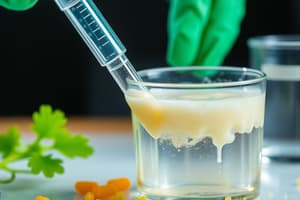Podcast
Questions and Answers
What fundamental concept did Antony van Leeuwenhoek contribute to biotechnology?
What fundamental concept did Antony van Leeuwenhoek contribute to biotechnology?
- Established the first genetic studies.
- Invented the electron microscope.
- Discovered cells using a simple microscope. (correct)
- Created the rabies vaccine.
Which type of biotechnology is primarily focused on agricultural applications?
Which type of biotechnology is primarily focused on agricultural applications?
- Green biotechnology (correct)
- Red biotechnology
- Gold biotechnology
- White biotechnology
What is the purpose of gene knockout experiments in research?
What is the purpose of gene knockout experiments in research?
- To discover new drug treatments.
- To create transgenic organisms.
- To enhance bacterial growth.
- To study the effects of disrupting a gene. (correct)
Which scientist is credited with the discovery of penicillin?
Which scientist is credited with the discovery of penicillin?
What aspect of biotechnology does bioremediation focus on?
What aspect of biotechnology does bioremediation focus on?
Which of the following is an example of blue biotechnology?
Which of the following is an example of blue biotechnology?
What is the primary focus of bio prospecting in biotechnology?
What is the primary focus of bio prospecting in biotechnology?
Which biotechnological pioneer was the first to observe cells in cork?
Which biotechnological pioneer was the first to observe cells in cork?
What percentage of a protein's weight is attributed to nitrogen?
What percentage of a protein's weight is attributed to nitrogen?
Which of the following is a role of proteins in biological systems?
Which of the following is a role of proteins in biological systems?
The Microbial Genome Program was initiated for what primary purpose?
The Microbial Genome Program was initiated for what primary purpose?
Which of these is NOT a category of microbial metabolism that genome sequencing aims to identify?
Which of these is NOT a category of microbial metabolism that genome sequencing aims to identify?
What is one function of stop codons in protein synthesis?
What is one function of stop codons in protein synthesis?
Which type of protein primarily functions as receptors in cell membranes?
Which type of protein primarily functions as receptors in cell membranes?
What does metagenomics involve?
What does metagenomics involve?
Which amino acid is recognized as the start codon in protein synthesis?
Which amino acid is recognized as the start codon in protein synthesis?
What role do growth mediators play in stem cell technologies?
What role do growth mediators play in stem cell technologies?
DNA profiling is also known as:
DNA profiling is also known as:
Which technique is used to alter, repair, or enhance an organism's genetic material?
Which technique is used to alter, repair, or enhance an organism's genetic material?
In the process of creating recombinant plasmid, which enzyme is primarily used to join DNA fragments?
In the process of creating recombinant plasmid, which enzyme is primarily used to join DNA fragments?
What is the primary use of forensic entomology in criminal investigations?
What is the primary use of forensic entomology in criminal investigations?
What is the function of a plasmid in genetic engineering?
What is the function of a plasmid in genetic engineering?
What does the term 'Central Dogma' refer to in molecular biology?
What does the term 'Central Dogma' refer to in molecular biology?
What is the purpose of analyzing body fluids and tissues in forensic toxicology?
What is the purpose of analyzing body fluids and tissues in forensic toxicology?
What role do metallothioneins play in bioremediation?
What role do metallothioneins play in bioremediation?
Which organisms are currently used to produce synthetic insulin?
Which organisms are currently used to produce synthetic insulin?
What is the main purpose of somatic cell nuclear transfer?
What is the main purpose of somatic cell nuclear transfer?
Which is NOT a product of cloning techniques mentioned in the content?
Which is NOT a product of cloning techniques mentioned in the content?
What is Golden Rice genetically modified to enhance?
What is Golden Rice genetically modified to enhance?
What role does an imbalance of microbes in the intestines potentially play in health?
What role does an imbalance of microbes in the intestines potentially play in health?
Which of the following is NOT a goal of the Human Microbiome Project?
Which of the following is NOT a goal of the Human Microbiome Project?
Which of the following describes the genetic code?
Which of the following describes the genetic code?
What is the primary function of proteins in biological systems?
What is the primary function of proteins in biological systems?
What is the first codon in the genetic sequence that signals the start of protein synthesis?
What is the first codon in the genetic sequence that signals the start of protein synthesis?
What kind of structures do proteins with more than one polypeptide chain have?
What kind of structures do proteins with more than one polypeptide chain have?
What is the role of ribosomes in protein synthesis?
What is the role of ribosomes in protein synthesis?
In a polypeptide backbone, what defines the unique properties of each amino acid?
In a polypeptide backbone, what defines the unique properties of each amino acid?
What is the function of chaperons in protein folding?
What is the function of chaperons in protein folding?
Which type of protein is characterized by a long, narrow shape?
Which type of protein is characterized by a long, narrow shape?
What is complementary DNA (cDNA) lacking compared to genomic DNA?
What is complementary DNA (cDNA) lacking compared to genomic DNA?
Which enzyme is primarily used in the production of fructose syrups?
Which enzyme is primarily used in the production of fructose syrups?
What is one of the key roles of FDA regulations in biotechnology drug production?
What is one of the key roles of FDA regulations in biotechnology drug production?
Which application do cellulases best serve in industrial contexts?
Which application do cellulases best serve in industrial contexts?
What was a significant historical challenge related to insulin production?
What was a significant historical challenge related to insulin production?
What role do proteases play in industrial applications?
What role do proteases play in industrial applications?
Flashcards
Biotechnology Definition
Biotechnology Definition
Manipulation of living things or organic material for human needs.
Antony van Leeuwenhoek
Antony van Leeuwenhoek
Scientist who used simple microscopes to discover cells.
Robert Hooke
Robert Hooke
Scientist who first observed cells in cork.
Louis Pasteur
Louis Pasteur
Signup and view all the flashcards
Ernst Ruska
Ernst Ruska
Signup and view all the flashcards
Sir Alexander Fleming
Sir Alexander Fleming
Signup and view all the flashcards
Gregor Johann Mendel
Gregor Johann Mendel
Signup and view all the flashcards
Red Biotechnology
Red Biotechnology
Signup and view all the flashcards
Gene Knockout
Gene Knockout
Signup and view all the flashcards
Bioremediation
Bioremediation
Signup and view all the flashcards
Aquatic Biotechnology
Aquatic Biotechnology
Signup and view all the flashcards
Genetic Engineering
Genetic Engineering
Signup and view all the flashcards
Bioprospecting
Bioprospecting
Signup and view all the flashcards
Medical Biotechnology
Medical Biotechnology
Signup and view all the flashcards
Bioremediation
Bioremediation
Signup and view all the flashcards
Metallothioneins
Metallothioneins
Signup and view all the flashcards
Restriction Enzymes
Restriction Enzymes
Signup and view all the flashcards
Insulin
Insulin
Signup and view all the flashcards
Golden Rice
Golden Rice
Signup and view all the flashcards
Clone
Clone
Signup and view all the flashcards
Somatic Cell Nuclear Transfer
Somatic Cell Nuclear Transfer
Signup and view all the flashcards
What have scientists cloned?
What have scientists cloned?
Signup and view all the flashcards
Gene therapy
Gene therapy
Signup and view all the flashcards
Stem cell technologies
Stem cell technologies
Signup and view all the flashcards
DNA Profiling
DNA Profiling
Signup and view all the flashcards
Bloodstain Pattern Analysis
Bloodstain Pattern Analysis
Signup and view all the flashcards
Forensic Toxicology
Forensic Toxicology
Signup and view all the flashcards
Forensic Entomology
Forensic Entomology
Signup and view all the flashcards
Genetic Engineering
Genetic Engineering
Signup and view all the flashcards
Recombinant DNA technology
Recombinant DNA technology
Signup and view all the flashcards
Plasmid
Plasmid
Signup and view all the flashcards
Transgenic biotechnology
Transgenic biotechnology
Signup and view all the flashcards
Reproductive cloning
Reproductive cloning
Signup and view all the flashcards
Programming of cells
Programming of cells
Signup and view all the flashcards
Restriction enzyme
Restriction enzyme
Signup and view all the flashcards
Sticky ends
Sticky ends
Signup and view all the flashcards
DNA ligase
DNA ligase
Signup and view all the flashcards
Central Dogma
Central Dogma
Signup and view all the flashcards
DNA Polymerase
DNA Polymerase
Signup and view all the flashcards
RNA Polymerase
RNA Polymerase
Signup and view all the flashcards
Ribosome
Ribosome
Signup and view all the flashcards
Genetic Code
Genetic Code
Signup and view all the flashcards
Amino Acid Code
Amino Acid Code
Signup and view all the flashcards
Stop Codons
Stop Codons
Signup and view all the flashcards
Proteins
Proteins
Signup and view all the flashcards
Protein Functions
Protein Functions
Signup and view all the flashcards
Protein Composition
Protein Composition
Signup and view all the flashcards
Protein Nitrogen Content
Protein Nitrogen Content
Signup and view all the flashcards
Microorganism Cell Wall Inhibition
Microorganism Cell Wall Inhibition
Signup and view all the flashcards
Microorganism Cell Membrane Inhibition
Microorganism Cell Membrane Inhibition
Signup and view all the flashcards
Microorganism Folic Acid Inhibition
Microorganism Folic Acid Inhibition
Signup and view all the flashcards
Microorganism DNA Inhibition
Microorganism DNA Inhibition
Signup and view all the flashcards
Microorganism Ribosome Inhibition
Microorganism Ribosome Inhibition
Signup and view all the flashcards
Microbial Genome Program (MGP)
Microbial Genome Program (MGP)
Signup and view all the flashcards
Metagenomics
Metagenomics
Signup and view all the flashcards
Microbiome
Microbiome
Signup and view all the flashcards
Gut Microbiome
Gut Microbiome
Signup and view all the flashcards
E. coli
E. coli
Signup and view all the flashcards
Streptococcus Pneumoniae
Streptococcus Pneumoniae
Signup and view all the flashcards
Protein Chaperons
Protein Chaperons
Signup and view all the flashcards
Protein Conformation
Protein Conformation
Signup and view all the flashcards
Globular Protein
Globular Protein
Signup and view all the flashcards
Fibrous Protein
Fibrous Protein
Signup and view all the flashcards
Introns
Introns
Signup and view all the flashcards
Exons
Exons
Signup and view all the flashcards
cDNA
cDNA
Signup and view all the flashcards
Amylases
Amylases
Signup and view all the flashcards
Proteases
Proteases
Signup and view all the flashcards
Lipases
Lipases
Signup and view all the flashcards
Industrial Enzyme Uses
Industrial Enzyme Uses
Signup and view all the flashcards
Biotechnology Drugs
Biotechnology Drugs
Signup and view all the flashcards
Target Protein Production
Target Protein Production
Signup and view all the flashcards
FDA
FDA
Signup and view all the flashcards
Human Microbiome
Human Microbiome
Signup and view all the flashcards
Microbial Diagnostics
Microbial Diagnostics
Signup and view all the flashcards
Bacterial Detection Strategies
Bacterial Detection Strategies
Signup and view all the flashcards
Human Microbiome Project Goals
Human Microbiome Project Goals
Signup and view all the flashcards
Central Dogma
Central Dogma
Signup and view all the flashcards
DNA Polymerase
DNA Polymerase
Signup and view all the flashcards
RNA Polymerase
RNA Polymerase
Signup and view all the flashcards
Genetic Code
Genetic Code
Signup and view all the flashcards
Codon
Codon
Signup and view all the flashcards
Amino Acid
Amino Acid
Signup and view all the flashcards
Protein
Protein
Signup and view all the flashcards
Polypeptide Backbone
Polypeptide Backbone
Signup and view all the flashcards
Primary Structure (Protein)
Primary Structure (Protein)
Signup and view all the flashcards
Secondary Structure (Protein)
Secondary Structure (Protein)
Signup and view all the flashcards
Tertiary Structure (Protein)
Tertiary Structure (Protein)
Signup and view all the flashcards
Quaternary Structure (Protein)
Quaternary Structure (Protein)
Signup and view all the flashcards
Study Notes
Introduction to Biotechnology
- Biotechnology is the manipulation of living organisms and organic material to meet human needs.
Colors of Biotechnology
- Red Biotechnology: Health, medical, and diagnostic applications.
- Green Biotechnology: Agricultural applications.
- White Biotechnology: Industrial applications.
- Brown Biotechnology: Food biotechnology, nutrition, bioinformatics, nanobiotechnology.
- Gold Biotechnology: Bioinformatics, nanobiotechnology, aquaculture, marine biotechnology.
- Violet Biotechnology: Legal aspects related to bio.
- Blue Biotechnology: Aquaculture, marine biotechnology.
- Grey Biotechnology: Environmental biotechnology.
- Dark Biotechnology: Bioterrorism, biowarfare.
- Purple Biotechnology: Patents, publications, inventions, and related areas.
Discoveries and Inventions
- Antony van Leeuwenhoek: Discovered cells using a simple microscope.
- Robert Hooke: Invented the compound light microscope; first to observe cells in cork.
- Louis Pasteur: Described the role of bacteria in spoilage and the scientific basis for fermentation; created the rabies vaccine.
- Ernst Ruska: Invented the electron microscope.
- Alexander Fleming: Discovered penicillin.
- Gregor Johan Mendel: Discovered genetics.
Gene Knockout
- Disrupting a gene in an animal to observe its function; researchers determine the role and function of the gene by observing the effects of the gene disruption, allowing for the study of the gene's influence on the organism.
- Bioremediation: Stimulated growth of bacteria to degrade components in crude oil from oil spills.
- Biotechnological research into aquatic organisms, and enzymes capable of degrading oil.
Genetic Engineering
- Vaccines against viruses which affect salmon.
- Transgenic salmon that produce growth hormone.
- Bio prospecting - searching for new genes and proteins for applications in human health and other fields.
- Marine plankton and snails are rich sources of antitumor and anticancer molecules.
- Using bacteria to produce insulin.
- Genetically modifying food crops (e.g., golden rice).
Forensic Biotechnology
- Fingerprinting for identifying people.
- DNA fingerprinting in forensic science:
- Restriction Fragment Length Polymorphism (RFLP)
- Polymerase Chain Reaction (PCR)
- Random Amplified Polymorphic DNA (RAPD)
- Inter-Simple Sequence Repeats (ISSR)
- Mitochondrial DNA Analysis (mtDNA)
- 4 Chromosome markers analysis.
- Alu repeats analysis.
- Identification of human remains, endangered species, and disease tracking.
Genetic Engineering Techniques
- Recombinant DNA Technology: techniques used to cut up and combine genetic material from different biological species using restriction enzymes. This allows scientists to combine genes and create new combinations of heritable genetic material.
- Plasmids: Small circular pieces of DNA which can replicate independently. They are ideal for inserting and replicating genes in bacteria or yeast.
- Transgenic biotechnology: Introducing foreign genes into an organism.
- Reproductive cloning: Creating genetically identical copies of organisms.
- Programming of cells.
- Forensic biotechnology: Using biotechnology techniques in legal settings.
- Determining the roles of particular genes, or gene pathways, in biological systems.
- Diagnosing diseases at an early stage using bio markers.
Restriction Enzymes
- Enzymes that bind to specific recognition sequences and cleave double-stranded DNA.
- Used for cutting out genes.
Insulin
- A peptide hormone that ensures glucose is absorbed by the cells for respiration, crucial for metabolic processes.
- Genetically engineered to produce insulin using bacteria and yeast.
Cloning
- "An exact genetic replica of another cell or organism".
The Central Dogma
- Replication: DNA to DNA.
- Transcription: DNA to RNA.
- Translation: RNA to protein.
- Genetic code is read from a specified starting point as triplet codons.
- Proteins that function as a polymer of amino acids that are synthesized from 20 amino acids.
Types of Proteins
- Structural organization, including primary, secondary, tertiary (3D structure), and quaternary (multiple polypeptide chains) protein structure.
- Chaperones are small proteins that help guide folding and prevent incorrect protein associations.
- Proteins can be folded spontaneous or by proteins called chaperones and the final folded shape is called conformation.
Complementary DNA (cDNA)
- Synthesized in the lab from mRNA.
- Not genomic DNA; lacks promoters and introns.
- Used to study gene expression.
- Reverse Transcriptase is used to make cDNA.
Enzymes and their industrial applications
- Enzymes are used in various industrial processes such as in food processing, textiles, leather goods, and treatment of heavy metals.
Biotechnology Drugs and other medical applications
- Produced through microbial fermentation or mammalian cell culture.
- Proteins, such as insulin, can be produced for therapeutic applications.
- Cell cultures provide specific conditions to produce proteins for various uses.
- Must strictly adhere to FDA regulations.
Microorganisms
- Microbiome: Genome of all microorganisms in a particular environment (e.g., gut).
- Microbes play vital roles in health and other aspects of wellness.
- Microbial genome sequencing and analysis are important.
- Microbial genomes studies and analysis to better understand microorganisms and their roles in health, disease, and the environment.
- Importance of identifying genes responsible for human and animal diseases.
- Microbial diagnosis helps detect and monitor microbes to prevent and control spread of infections.
Studying That Suits You
Use AI to generate personalized quizzes and flashcards to suit your learning preferences.




